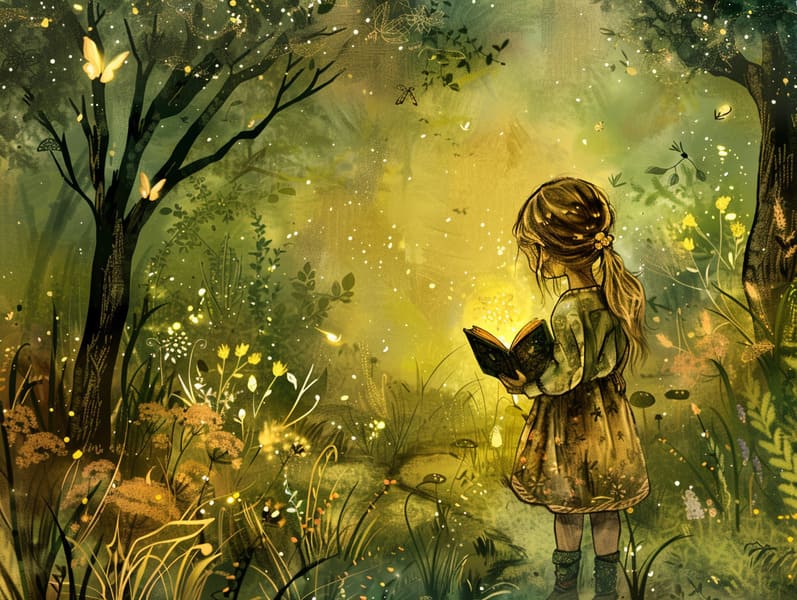
Fairy tales have deep roots. These tales have been narrated from one generation to the next far before they were ever published. They sprang from a variety of societies, including Asian traditions. They were initially disseminated among elders, often carrying themes and messages pertaining to the societal norms and beliefs of the time.
The renowned Brothers Grimm, Jacob and Wilhelm, were among the first to assemble many of these beloved narratives. Their collection, "Grimm's Fairy Stories," included tales like "Cinderella," "The Bread Crumb Trail," and "Little Snow White," which have since become hallmarks in the world of iconic fairy tales. Similarly, Andersen's imaginative tales, such as "The Sea Maid," and "The Story of the Ugly Duckling," have won hearts worldwide, guaranteeing their place in the pantheon of timeless fairy tales.
Even though they are old, these tales remain as significant as ever, especially as children's bedtime stories. These enchanting tales are now available in diverse formats, including artistically illustrated books, fantastical animations, and online storybooks.
Their lasting appeal can be ascribed to several captivating elements:
Life Lessons: Timeless fairy tales often present important moral lessons. Fairy tales like "The Story of the Boy Who Cried Wolf" teach the importance of truth, while "The Race of the Tortoise and the Hare" highlight the traits of perseverance and modesty. These narratives offer the young clear distinctions between virtue and vice, forming their moral compass in a soft yet meaningful way.
Sympathy and Perception: Timeless fairy tales frequently feature protagonists facing challenges and struggles, motivating audiences to understand with their struggles and cheer for their triumphs. For instance, "Beauty's Beast" reveals the importance of seeing beyond the surface to know the true being of a character, cultivating warmth and comprehension.
Cultural Awareness: Many classic fairy tales are deeply ingrained in the cultural contexts from which they arose. Learning from these narratives can provide captivating looks into different heritages, advancing a sense of world understanding and understanding.
Creativity and Fantasy: The fantastical elements in traditional fairy tales—magical kingdoms—revitalize children’s fantasy worlds. These fairy tales transport readers to otherworldly realms, fostering imaginative ideas and a sense of awe that stays a lifetime.
Timeless fairy tales are not only mesmerizing but also educational. They work as whimsical tools in promoting various mental and emotional abilities in young readers. When traditional fairy tales are recited, they promote speech development by presenting new vocabulary and complex sentence structures. This practice also promotes auditory perception and attentiveness, as young readers follow the story, eager to see what happens next.
Furthermore, reflecting on the themes and characters of traditional fairy tales can develop analytical skills and intellectual skills. The young are taught to pinpoint patterns, expect results, and get cause and effect. These talks also further awesome site the young express their thoughts and feelings, cultivating their emotional intelligence.
In today’s technological age, the existence of free fairy tales online has made these stories more acquirable than ever. Web-based platforms and software offer comprehensive collections of timeless fairy tales that can be enjoyed or listened on anytime, anywhere. Fairy tales recited are particularly well-liked, supplying an interactive method for young ones to delight in these charming stories. Narrated books and read-to-me videos move characters and settings to life, often supplemented by bewitching music and music that raise the narrative adventure.
The everlasting appeal of old fairy tales lies in their ability to transform to contemporary times while keeping hold of their basic principles. Contemporary reinterpretations of these narratives often incorporate more multicultural protagonists and modern settings, making them relevant to today’s audience. However, the fundamental themes of valour, empathy, and justice remain unchanged, continuing to touch listeners of all ages.
Traditional fairy tales also offer a sense of reassurance and homeliness. They grant access to a methodical narrative with a apparent beginning, middle, and end, often finishing with the wrap-up of conflicts and the triumph of virtue over corruption. This dependability can be comforting for the young, showcasing a sense of solidity in an ever-changing world.
Old fairy tales continue to enthrall and edify new generations, maintaining their splendor and pertinence in modern society. As children's night stories, they give a perfect blend of fascination and comprehension, supporting moral values, empathy, and creativity. The accessibility of web-based fairy tales and the likability of fairy tales narrated guarantee that these timeless fairy tales remain available to new generations.
By perpetuating and narrating these tales, we continue to recognize the rich tapestry of legends and cultural heritage. Whether you are perusing a colorful picture book, delving into a electronic library, or listening on an voice book, the splendor of bedtime fairy tales is always within reach. These tales point out of the unchanging spell of narratives and its ability to hold us together across centuries and lands.
Regardless if you are experiencing a vividly illustrated book, viewing a virtual library, or listening on an narrated book, the grace of timeless fairy tales is always within reach.
These fairy tales teach us of the unending essence of stories and its ability to link us across centuries and lands, establishing a link that fascinates and enlightens alike.